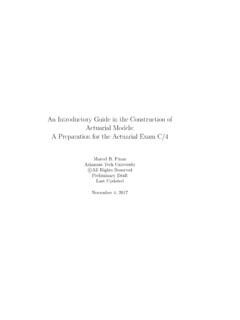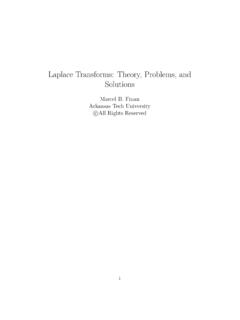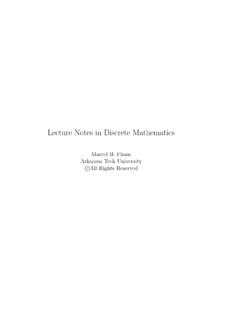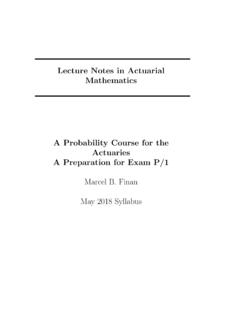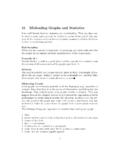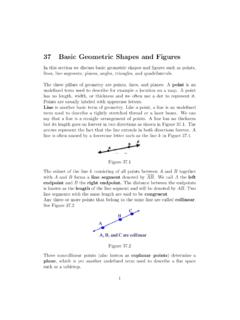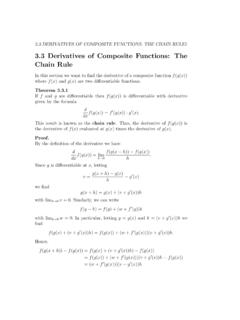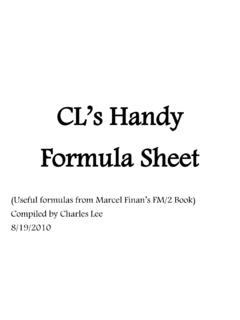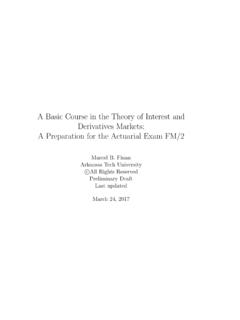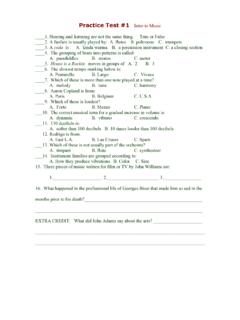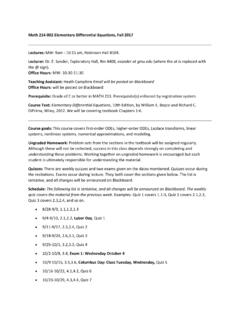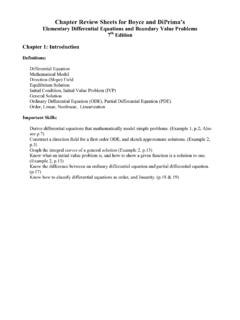Transcription of A Second Course in Elementary Di erential Equations
1 A Second Course in Elementary DifferentialEquationsMarcel B. FinanArkansas Tech Universityc All Rights ReservedAugust 3, 20131 Contents28 Calculus of Matrix-Valued Functions of a Real Variable429 nth Order Linear Differential Equations :Existence and Unique-ness1930 The General Solution of nth Order Linear Homogeneous Equa-tions2631 Fundamental Sets and Linear Independence3632 Higher Order Homogeneous Linear Equations with ConstantCoefficients4333 Non Homogeneous nth Order Linear Differential Equations 5034 Existence and Uniqueness of Solution to Initial Value FirstOrder Linear Systems6035 Homogeneous First Order Linear Systems6836 First Order Linear Systems: Fundamental Sets and LinearIndependence7937 Homogeneous Systems with Constant Coefficients8838 Homogeneous Systems with Constant Coefficients.
2 ComplexEigenvalues9839 Homogeneous Systems with Constant Coefficients: RepeatedEigenvalues10240 Nonhomogeneous First Order Linear Systems11441 Solving First Order Linear Systems with Diagonalizable Con-stant Coefficients Matrix12442 Solving First Order Linear Systems Using Exponential Ma-trix133243 The Laplace Transform: Basic Definitions and Results13944 Further Studies of Laplace Transform15145 The Laplace Transform and the Method of Partial Fractions16446 Laplace Transforms of Periodic Functions17147 Convolution Integrals18148 The Dirac Delta Function and Impulse Response18949 Solving Systems of Differential Equations Using Laplace Trans-form19750 Numerical Methods for Solving First Order Linear Systems:Euler s Method204328 Calculus of Matrix-Valued Functions of aReal VariableIn establishing the existence result for Second and higher order linear differ-ential Equations one transforms the equation into a linear system and triesto solve such a system.
3 This procedure requires the use of concepts suchas the derivative of a matrix whose entries are functions oft,the integralof a matrix, and the exponential matrix function. Thus, techniques frommatrix theory play an important role in dealing with systems of differentialequations. The present section introduces the necessary background in thecalculus of matrix Functions of a Real VariableAmatrix A of dimensionm nis a rectangular array of the formA= .. amn where theaij s are theentriesof the matrix,mis the number of rows,nis the number of columns. Thezero matrix 0is the matrix whose entriesare all 0. Then nidentity matrix Inis a square matrix whose maindiagonal consists of 1 sand the off diagonal entries are all 0. A matrixAcanbe represented with the following compact notationA= (aij).
4 The entryaijis located in the ith row and jth the matrixA(t) = 50110 20 52 7 Finda22, a32, entrya22is in the Second row and Second column so thata22= ,a32= 2 anda23= 04 Anm narray whose entries are functions of a real variable defined ona common interval is called amatrix , the matrixA(t) = a11(t)a12(t)a13(t)a21(t)a22(t)a23(t)a31( t)a32(t)a33(t) is a 3 3 matrix function whereas the matrixx(t) = x1(t)x2(t)x3(t) is a 3 1 matrix function also known as avector-valued will denote anm nmatrix function byA(t) = (aij(t)) whereaij(t) isthe entry in the ith row and jth of Matrix FunctionsAll the familiar rules of matrix arithmetic hold for matrix functions as well.(i)Equality:Twom nmatricesA(t) = (aij(t)) andB(t) = (bij(t)) aresaid to be equal if and only ifaij(t) =bij(t) for all 1 i mand 1 j is, two matrices are equal if and only if all corresponding elements areequal.
5 Notice that the matrices must be of the same the following matrix equation fora,b,c,andd[a b b+c3d+c2a 4d]=(8 17 6) corresponding entries we get the system a b= 8b+c= 1c+ 3d= 72a 4d= 6 Adding the first two Equations to obtaina+c= 4 times the thirdequation to 3 times the last equation to obtain 6a+ 4c= 46 or 3a+ 2c= the two Equations inaandcone findsa= 5 andc= ,b= 3 andd= 1(ii)Addition:IfA(t) = (aij(t)) andB(t) = (bij(t) arem nmatricesthen the sum is a newm nmatrix obtained by adding corresponding ele-ments(A+B)(t) =A(t) +B(t) = (aij(t) +bij(t))Matrices of different dimensions cannot be added.(iii)Subtraction:LetA(t) = (aij(t)) andB(t) = (bij(t)) be twom nmatrices. Then the difference (A B)(t) is the new matrix obtained bysubtracting corresponding elements,that is(A B)(t) =A(t) B(t) = (aij(t) bij(t))(iv)Scalar Multiplication:If is a real number andA(t) = (aij(t)) is anm nmatrix then ( A)(t) is them nmatrix obtained by multiplying theentries ofAby the number ; that is,( A)(t) = A(t) = ( aij(t))(v)Matrix Multiplication:IfA(t) is anm nmatrix andB(t) is ann pmatrix then the matrixAB(t) is them pmatrixAB(t) = (cij(t))wherecij(t) =n k=1aik(t)bkj(t)That is thecijentry is obtained by multiplying componentwise the ith rowofA(t) by the jth column ofB(t).)
6 It is important to realize that the orderof the multiplicands is significant, in other wordsAB(t) is not necessarilyequal toBA(t). In mathematical terminology matrix multiplication is [1 23 2],B=[2 1 34]Show thatAB6= , matrix multiplication is not the definition of matrix multiplication we findAB=[ 4 70 5],BA=[ 1 29 2]Hence,AB6=BA(vi)Inverse:Ann nmatrixA(t) is said to beinvertibleif and only ifthere is ann nmatrixB(t) such thatAB(t) =BA(t) =IwhereIis thematrix whose main diagonal consists of the number 1 and 0 elsewhere. Wedenote theinverseofA(t) byA 1(t).Example the inverse of the matrixA=[a bc d]given thatad bc6= quantityad bcis called thedeterminantofAand is denoted thatA 1=[x yz t]Then[x yz t][a bc d]=[1 00 1]This implies that[ax+cy bx+dyaz+ct bz+dt]=[1 00 1]Hence,ax+cy= 1bx+dy= 0az+ct= 0bz+dt= 1 Applying the method of elimination to the first two Equations we find7x=dad bcandy= bad bcApplying the method of elimination to the last two Equations we findz= cad bcandt=aad bcHence,A 1=1ad bc[d b c a]Norm of a Vector FunctionThe norm of a vector function will be needed in the coming sections.
7 In onedimension a norm is known as the absolute value. In multidimenesion, wedefine the norm of a vector functionxwith componentsx1,x2, ,xnby||x||=|x1|+|x2|+ +|xn|.From this definition one notices the following properties:(i) If||x||= 0 then|x1|+|x2|+ +|xn|= 0 and this implies that|x1|=|x2|= =|xn|= ,x=0.(ii) If is a scalar then|| x||=| x1|+| x2|+ +| xn|=| |(|x1|+|x2|+ +|xn|) =| |||x||.(iii) Ifxis vector function with componentsx1,x2, ,xnandywith com-ponentsy1,y2, ,ynthen||x+y||=|x1+y1|+|x2+y2|+ +|xn+yn| (|x1|+|x2|+ +|xn|) + (|y1|+|y2|+ +|yn|)=||x||+||y||Limits of Matrix FunctionsIfA(t) = (aij(t)) is anm nmatrix such that limt t0aij(t) =Lijexists forall 1 i mand 1 j nthen we definelimt t0A(t) = (Lij)Example thatA(t) =[t2 5t t32t3]Find limt 1A(t). 1A(t) =[limt 1(t2 5t) limt 1t3limt 12tlimt 13]=[ 4 123]If one or more of the component function limits does not exist, then the limitof the matrix does not exist.
8 For example, ifA(t) =[t t 10et]then limt 0 Adoes not exist since limt 01tdoes not say thatA(t) iscontinuousatt=t0iflimt t0A(t) =A(t0)Example that the matrixA(t) =[t t 10et]is continuous att= 1A(t) =[2 1/20e2]=A(1)we haveA(t) is continuous att= 1 Most properties of limits for functions of a single variable are also valid forlimits of matrix DifferentiationLetA(t) be anm nmatrix such that each entry is a differentiable define thederivativeofA(t) to beA (t) = limh 0A(t+h) A(t)hprovided that the limit (t) =[a11(t)a12(t)a21(t)a22(t)]where the entriesa11,a12,a21,anda22are differentiable. FindA (t). haveA (t) =limh 0A(t+h) A(t)h=[limh 0a11(t+h) a11(t)hlimh 0a12(t+h) a12(t)hlimh 0a21(t+h) a21(t)hlimh 0a22(t+h) a22(t)h]=[a 11(t)a 12(t)a 21(t)a 22(t)]It follows from the previous example that the derivative of a matrix functionis the matrix of derivatives of its component functions.
9 From this fact onecan check easily the following two properties of differentiation:(i) IfA(t) andB(t) are twom nmatrices with both of them differentiablethen the matrix(A + B)(t) is also differentiable and(A+B) (t) =A (t) +B (t)(ii) IfA(t) is anm ndifferentiable matrix andB(t) is ann pdifferentiablematrix then the product matrixAB(t) is also differentiable and(AB) (t) =A (t)B(t) +A(t)B (t)Example the systemy 1=a11(t)y1(t) +a12(t)y2(t) +a13(t)y3(t) +g1(t)y 2=a21(t)y1(t) +a22(t)y2(t) +a23(t)y3(t) +g2(t)y 3=a11(t)y1(t) +a12(t)y2(t) +a13(t)y3(t) +g3(t)in matrix (t) = y1(t)y2(t)y3(t) ,A(t) = a11(t)a12(t)a13a21(t)a22(t)a23a31a32a33 ,g(t) = g1(t)g2(t)g3(t) Then the given system can be written in the matrix formy (t) =A(t)y(t) +g(t)Matrix Integration:Since the derivative of a matrix function is a matrix of derivatives, it shouldnot be surprising that antiderivatives of a matrix function can be evaluatedby performing the corresponding antidifferentiation operations upon eachcomponent of the matrix function.
10 That is, ifA(t) is them nmatrixA(t) = a11(t)a12(t) a1n(t)a21(t)a22(t) a2n(t)..am1(t)am2(t) amn(t) then A(t)dt= a11(t)dt a12(t)dt a1n(t)dt a21(t)dt a22(t)dt a2n(t) am1(t)dt am2(t)dt amn(t)dt Example the matrix functionA(t) ifA (t) =[2t1cost3t2] haveA(t) =[t2+c11t+c12sint+c21t3+c22]=[t2tsint t3]+[c11c12c21c22]11 Finally, we conclude this section by showing that|| tt0x(s)ds|| tt0||x(s)||dsTo see this,|| tt0x(s)ds||= tt0x1(s)ds tt0x2(s) tt0xn(s)ds =| tt0x1(s)ds|+| tt0x2(s)ds|+ | tt0xn(s)ds| tt0|x1(s)|ds+ tt0|x2(s)|ds+ + tt0|xn(s)|ds= tt0(|x1|+|x2|+ +|xn|)ds= tt0||x(s)||ds12 Practice ProblemsProblem the following matricesA(t) =[t 1t222t+ 1],B(t) =[t 10t+ 2],c(t) =[t+ 1 1](a) Find 2A(t) - 3tB(t)(b) FindA(t)B(t) -B(t)A(t)(c) FindA(t)c(t)(d) Find det(B(t)A(t))Problem all valuestsuch thatA(t)
